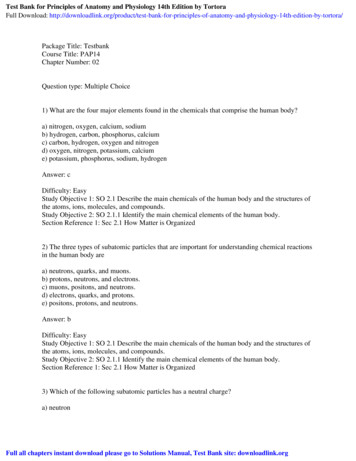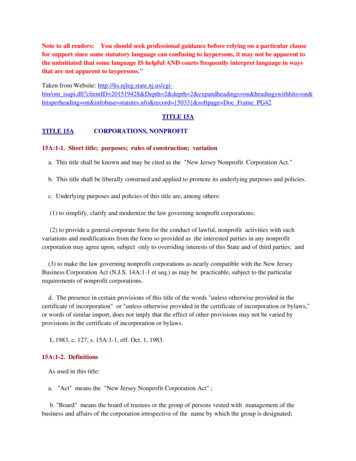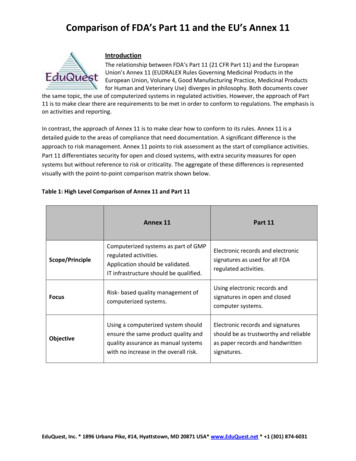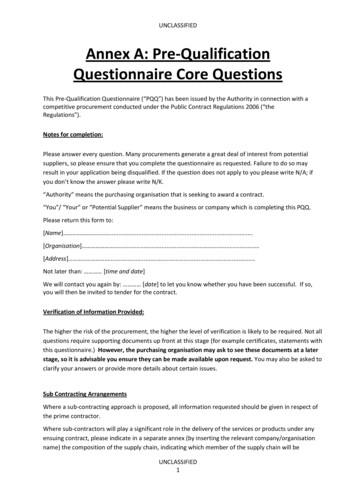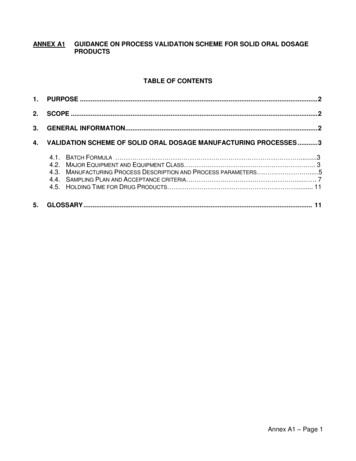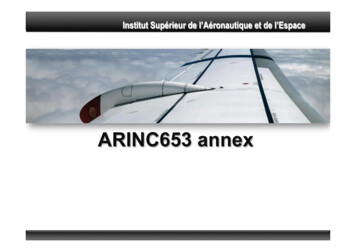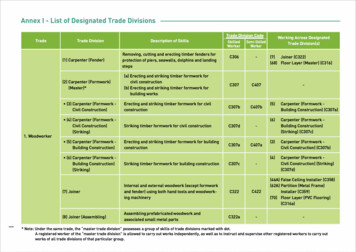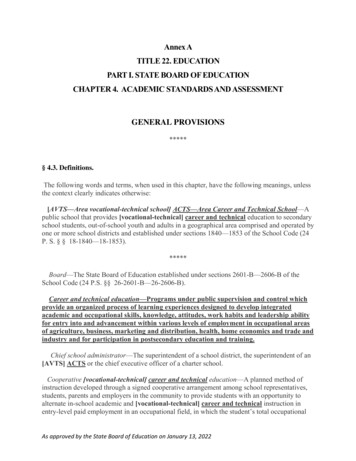
Transcription
Annex ATITLE 22. EDUCATIONPART I. STATE BOARD OF EDUCATIONCHAPTER 4. ACADEMIC STANDARDS AND ASSESSMENTGENERAL PROVISIONS*****§ 4.3. Definitions.The following words and terms, when used in this chapter, have the following meanings, unlessthe context clearly indicates otherwise:[AVTS—Area vocational-technical school] ACTS—Area Career and Technical School—Apublic school that provides [vocational-technical] career and technical education to secondaryschool students, out-of-school youth and adults in a geographical area comprised and operated byone or more school districts and established under sections 1840—1853 of the School Code (24P. S. § § 18-1840—18-1853).*****Board—The State Board of Education established under sections 2601-B—2606-B of theSchool Code (24 P.S. §§ 26-2601-B—26-2606-B).Career and technical education—Programs under public supervision and control whichprovide an organized process of learning experiences designed to develop integratedacademic and occupational skills, knowledge, attitudes, work habits and leadership abilityfor entry into and advancement within various levels of employment in occupational areasof agriculture, business, marketing and distribution, health, home economics and trade andindustry and for participation in postsecondary education and training.Chief school administrator—The superintendent of a school district, the superintendent of an[AVTS] ACTS or the chief executive officer of a charter school.Cooperative [vocational-technical] career and technical education—A planned method ofinstruction developed through a signed cooperative arrangement among school representatives,students, parents and employers in the community to provide students with an opportunity toalternate in-school academic and [vocational-technical] career and technical instruction inentry-level paid employment in an occupational field, in which the student’s total occupationalAs approved by the State Board of Education on January 13, 2022
work experience is planned, coordinated and supervised by the school in close cooperation withthe employer.*****Employment area—A geographic area where [vocational-technical] career and technicaleducation program completers are most likely to be employed.*****School entity—A local public education provider (for example, public school district, charterschool, cyber charter school, [AVTS] ACTS or intermediate unit).School organization—The organization of a school district’s programs into kindergarten,primary, intermediate level, middle level and high school programs, including programs operatedat [AVTSs] ACTSs.*****Tech-prep program—A combined secondary and postsecondary program which leads to anassociate degree or certificate and employment by providing technical preparation in engineeringtechnology, applied science, mechanical, industrial or practical art or trade, agriculture, health orbusiness, including development of competence in mathematics, science and communicationsthrough a sequential course of study.[Vocational-technical education—Programs under public supervision and control whichprovide an organized process of learning experiences designed to develop integratedacademic and occupational skills, knowledge, attitudes, work habits and leadership abilityfor entry into and advancement within various levels of employment in occupational areasof agriculture, business, marketing and distribution, health, home economics and trade andindustry and for participation in postsecondary education and training.]§ 4.4. General policies.*****(e) The Department will provide support to school districts, [AVTSs] ACTSs and charterschools, including cyber charter schools, in developing educational programs that enablestudents to attain academic standards under § 4.12. Department support will include:(1) Establishment of a voluntary model curriculum and diagnostic supports aligned with Stateacademic standards in each of the content areas assessed by the Keystone Exams under§ 4.51b(i) and (j) (relating to Keystone Exams).(2) Assistance in the development of effective student tutoring, remediation and extendedinstructional time programs.As approved by the State Board of Education on January 13, 2022
(3) Opportunities for continuing professional education designed to improve instruction ineach of the content areas assessed by the Keystone Exams under § 4.51b(i) and (j).(4) Technical guidance in developing local assessments that meet the requirements of§ 4.24(c)(1)(iii)(B) (relating to high school graduation requirements), upon request.(f) The Department may not, and the Board will not, require school entities to utilize aStatewide curriculum or Statewide reading lists.ACADEMIC STANDARDS AND PLANNING§ 4.11. Purpose of public education.*****(g) Public schools provide instruction throughout the curriculum so that students may developknowledge and skills in the following areas:(1) English language arts.(2) Mathematics.(3) Science and [technology] environment and ecology.(4) [Environment and ecology] Technology and engineering.(5) Social studies (civics and government, geography, economics and history).(6) Arts and humanities.(7) Career education and work.(8) Health, safety and physical education.(9) Family and consumer science.*****§ 4.12. Academic standards.(a) School entities may develop, expand or improve existing academic standards in thefollowing content areas:(1) The following apply:(i) Through June 30, 2024 2025: Science and technology. Study of the natural world andfacts, principles, theories and laws in the areas of biology, chemistry, physics and earthsciences. Technology is the application of science to enable societal development, includingfood and fiber production, manufacturing, building, transportation and communication.Science and technology share the use of the senses, science processes, inquiry, investigation,analysis and problem solving strategies. The Pennsylvania Core Standards for Reading inAs approved by the State Board of Education on January 13, 2022
Science and Technology and the Pennsylvania Core Standards for Writing in Science andTechnology will be an appendix to the Commonwealth’s academic standards for Science andTechnology upon publication in the Pennsylvania Bulletin.(ii) Effective July 1, 2024 2025: Pennsylvania Integrated Standards for Science,Environment, Ecology, Technology, and Engineering (Grades K-5). Guide the elementarylevel study of the natural and human-made world through inquiry, problem-solving,critical thinking, and authentic exploration. The integration of these disciplines in theelementary grades highlights the interconnectedness of scientific study and the integralrelationship between humans and the environment.(2) The following apply:(i)Through June 30, 2024 2025: Environment and ecology. Understanding thecomponents of ecological systems and their interrelationships with social systems andtechnologies. These components incorporate the disciplines of resource management,agricultural diversity, government and the impact of human actions on naturalsystems. This interaction leads to the study of watersheds, threatened and endangeredspecies, pest management and the development of laws and regulations.(ii)Effective July 1, 2024 2025: Pennsylvania Integrated Standards for Science,Environment and Ecology (Grades 6-12). Utilize a three-dimensional approach toguide the study of physical sciences, life sciences, and earth and space sciences atthe middle and high school levels. The standards highlight the criticalintersections of these disciplines with environmental science, ecology, andagriculture. These three-dimensional standards integrate disciplinary core ideas,practices in science and engineering, and crosscutting concepts into coherentlearning progressions across the grade bands.(iii)Effective July 1, 2024 2025: Pennsylvania Technology and Engineering Standards(Grades 6-12). Define the knowledge, skills, and abilities necessary forestablishing literacy in technology and engineering literacy. Students develop apractical understanding of how humans are influenced by science andtechnology. Four core disciplinary standards describe practices in technologyand engineering and include specific benchmarks for students in grade bands 6-8and 9-12.(3) Social studies.(i) History. Study of the record of human experience including important events; interactionsof culture, race and ideas; the nature of prejudice; change and continuity in political systems;effects of technology; importance of global-international perspectives; and the integration ofgeography, economics and civics studies on major developments in the history of theCommonwealth, the United States and the world.*****As approved by the State Board of Education on January 13, 2022
(5) Career education and work. Understanding career options in relationship to individualinterests, aptitudes and skills including the relationship between changes in society, technology,government and economy and their effect on individuals and careers. Development ofknowledge and skill in job-seeking and job-retaining skills and, for students completing[vocational-technical] career and technical education programs, the skills to succeed in theoccupation for which they are prepared.*****(i) [Every 3 years] No sooner than every 5 years and no later than every ten years, theBoard will review the State academic standards and State assessments under this section todetermine if they are appropriate, clear, specific and challenging, and will make revisions asnecessary by revising this chapter.(j) The Department may not expand the collection of student data and, in accordance withsection 444 of the Family Educational Rights and Privacy Act of 1974 (20 U.S.C.A. § 1232g),regarding family educational and privacy rights, may not collect personal family data due to theimplementation of Pennsylvania Core Standards in Appendix A-2.*****CURRICULUM AND INSTRUCTION§ 4.21. Elementary education: primary and intermediate levels.(a) The primary program shall ordinarily be completed by children who are approximately [8] 6years of age. School districts, including charter schools, shall provide opportunities forindividualized rates of learning and social and emotional development that reflect differing ratesof development and learning styles of young children.*****(e) Planned instruction aligned with academic standards in the following areas shall be providedto every student every year in the primary program. Planned instruction may be provided asseparate course or other interdisciplinary activity.(1) Language arts, integrating reading, writing, phonics, spelling, listening, speaking, literatureand grammar, and information management, including library skills.(2) Mathematics, including problem-solving and computation skills.(3) Science, environment and [technology education] ecology, involving active learningexperiences for students.(4) [Environment and ecology] Technology and engineering education, involving activelearning experiences for students.*****As approved by the State Board of Education on January 13, 2022
(f) Planned instruction in the following areas shall be provided to every student every year inthe intermediate level program. Planned instruction may be provided as a separate course or asan instructional unit within another course or other interdisciplinary instructional activity:(1) Language arts, integrating reading, writing, spelling, listening, speaking, literature andgrammar.(2) Mathematics, including problem-solving and computation skills.(3) Science, environment and [technology] ecology, including instruction about agricultureand agricultural science.(4) [Environment and ecology, including instruction about agriculture and agriculturalscience] Technology and Engineering.(5) Social studies (civics and government, economics, geography and history).*****§ 4.22. Middle level education.*****(c) Planned instruction aligned with academic standards in the following areas shall be providedto every student in the middle level program. Planned instruction may be provided as a separatecourse or as an instructional unit within a course or other interdisciplinary instructional activity:(1) Language arts, integrating reading, writing, listening, speaking, literature and grammar.(2) Mathematics, including mathematical reasoning, algebra and problem-solving.(3) Science, environment and [technology] ecology, which involves active learningexperiences and which may include laboratory experiments [and], instruction in agriculture andagricultural science, and political and economic aspects of ecology.(4) Social studies (civics and government, economics, geography and history, including thehistory and cultures of the United States, the Commonwealth, and the world).(5) [Environment and ecology, including social, political and economic aspects of ecology,and instruction in agriculture and agricultural science] Technology and Engineering.(6) Information skills, including access to traditional and electronic information sources,computer use and research.(7) Health, safety and physical education, including instruction in concepts and skills whichaffect personal, family and community health and safety, nutrition, physical fitness, movementconcepts, motor skill development, safety in physical activity settings, and the prevention ofalcohol, chemical and tobacco abuse.(8) The arts, including art, music, dance and theatre.(9) Career education, including exposure to various career options and the educationalpreparation necessary to achieve those options.As approved by the State Board of Education on January 13, 2022
(10) Technology education, emphasizing practical application of academic skills and problemsolving experiences facilitated by technology.(11) Family and consumer science, including principles of consumer behavior and basicknowledge of child health and child care skills.(d) This section does not preclude the teaching of other planned instruction designed toachieve a school entity's academic standards.(e) School entities shall determine the most appropriate way to operate their middle levelprograms to achieve the purposes under subsection (b) and any additional academic standards asdetermined by the school entity.*****§ 4.23. High school education.*****(c) Planned instruction aligned with academic standards in the following areas shall be providedto every student in the high school program. Planned instruction may be provided as a separatecourse or as an instructional unit within a course or other interdisciplinary instructional activity:(1) Language arts, integrating reading, writing, listening, speaking, literature and grammar.(2) Mathematics, including problem-solving, mathematical reasoning, algebra, geometry andconcepts of calculus.(3) Science, environment and [technology] ecology, including scientific, social, politicaland economic aspects of ecology, participation in hands-on experiments and at least onelaboratory science chosen from life sciences, earth and space sciences, chemical sciences,physical sciences and agricultural sciences.(4) Social studies (civics and government, economics, geography and history, including thehistory and cultures of the United States, the Commonwealth and the world).(5) [Environment and ecology, including scientific, social, political and economic aspectsof ecology] Technology and Engineering.(6) The arts, including art, music, dance, theatre and humanities.(7) Use of applications of microcomputers and software, including word processing, database,spreadsheets and telecommunications; and information skills, including access to traditional andelectronic information sources, computer use and research.(8) Health, safety and physical education, including instruction in concepts and skills whichaffect personal, family and community health and safety, nutrition, physical fitness, movementconcepts, motor skill development, safety in physical activity settings, and the prevention ofalcohol, chemical and tobacco abuse.(9) Family and consumer science, including principles of consumer behavior and basicknowledge of child health, child care and early literacy skill development.As approved by the State Board of Education on January 13, 2022
(d) The following planned instruction shall be made available to every student in the highschool program:(1) [Vocational-technical] Career and technical education under § § 4.3 and 4.31—4.35.(2) Business education, including courses to assist students in developing business andinformation technology skills.(3) World languages under § 4.25 (relating to languages).(4) Technology education, incorporating technological problem-solving and the impacts oftechnology on individuals and society.(e) College-level advanced placement courses may be offered as planned instruction in the highschool curriculum.(f) This section does not preclude the teaching of other planned instruction designed to achievea school district's, including a charter school's, academic standards.(g) School districts, including a charter school, shall determine the most appropriate way tooperate their high school programs to achieve the purposes under subsection (a) and anyadditional academic standards as determined by the school entity.*****§ 4.24. High school graduation requirements.(a) Approval. High school graduation requirements and revisions to them shall be approved bya school entity’s governing board [by September 2, 2014] no later than the beginning of the2020-2021 school year, and a copy of the requirements shall be published and distributed tostudents, parents and guardians. Copies of the requirements also shall be available in each schoolbuilding or on each school entity’s publicly accessible web site. Changes to high schoolgraduation requirements shall be published and distributed to students, parents and guardians andmade available in each school building or on each school entity’s publicly accessible web siteimmediately following approval by the governing board.(b) Requirements through the 2015-2016 2021-2022 school year. Each school district, charterschool (including a cyber charter school) and [AVTS] ACTS, if applicable, shall specifyrequirements for graduation. Requirements through the 2015-2016 2021-2022 school year mustinclude course completion and grades, completion of a culminating project, results of localassessments aligned with the academic standards and a demonstration of proficiency in EnglishLanguage Arts and Mathematics on either the State assessments administered in grade 11 or 12or local assessments aligned with academic standards and State assessments under § 4.52(relating to local assessment system) at the proficient level or better to graduate. The purpose ofthe culminating project is to assure that students are able to apply, analyze, synthesize andevaluate information and communicate significant knowledge and understanding.(c) Requirements beginning in the [2016-2017] 2022-2023 school year.As approved by the State Board of Education on January 13, 2022
(1) General. Beginning in the [2016-2017] 2022-2023 school year, each school district,charter school (including a cyber charter school) and [AVTS] ACTS, if applicable, shall adoptand implement requirements for high school graduation that, at minimum, include:(i) Course completion and grades.(ii) Demonstration of proficiency as determined by the school district, charter school(including a cyber charter school) or [AVTS] ACTS, if applicable, in each of the State academicstandards not assessed by a State assessment under § 4.51, § 4.51a or § 4.51b (relating to Stateassessment system; Pennsylvania System of School Assessment; and Keystone Exams).(iii) Demonstration of proficiency or above in each of the following State academicstandards: English Language Arts and Mathematics (Appendix A-2); THROUGH JUNE 30,2025, Science and [Technology] and Environment and Ecology [(Appendix B)], AND,BEGINNING JULY 1, 2025, SCIENCE, ENVIRONMENT AND ECOLOGY (Appendix B1), as determined through any one or a combination of the following:(A) Completion of secondary level coursework in English Language Arts (Literature),Algebra I and Biology in which a student demonstrates proficiency on the associated KeystoneExam or [related project-based assessment if § 4.4(d)(4) (relating to general policies)applies] through a pathway established in section 121(c) or section 121(c.1) of the PublicSchool Code of 1949 (24 P.S. §§ 1-121(c) or (c.1)).(I) A school district, [AVTS] ACTS or charter school, including a cyber charter school,shall allow a student to take a Keystone Exam prior to taking the course associated with theexam’s content provided that the student achieved a score of advanced on the most recentassociated PSSA assessment administered to the student.(II) A school district, [AVTS] ACTS or charter school, including a cyber charter school,shall allow a student who transfers from another state to take a Keystone Exam prior to takingthe course associated with the exam’s content, provided that the student achieved a scorecomparable to the PSSA’s advanced performance level on a comparable assessmentadministered by another state.(III) A school district, [AVTS] ACTS or charter school, including a cyber charter school,may allow a student who scores at the advanced level on a particular Keystone Exam prior totaking the course to be granted course credit for the course without having to complete thecourse.(B) Locally approved and administered assessments, which shall be independently andobjectively validated once every 6 years. Local assessments may be designed to include a varietyof assessment strategies listed in § 4.52(c) and may include the use of one or more KeystoneExams. Except for replacement of individual test items that have a similar level of difficulty, anew validation is required for any material changes to the assessment. Validated localassessments must meet the following standards:(I) Alignment with the following State academic standards: English Language Arts(Literature and Composition); Mathematics (Algebra I), AND Science and [Technology,]Environment and Ecology (Biology)[, and Civics and Government].As approved by the State Board of Education on January 13, 2022
(II) Performance level expectations and descriptors that describe the level of performancerequired to achieve proficiency comparable to that used for the Keystone Exams.(III) Administration of the local assessment to all students, as a requirement forgraduation, except for those exempted by their individualized education program undersubsection [(g)] (d), regarding special education students, or gifted individualized education planas provided in § 16.32 (relating to GIEP).(IV) Subject to appropriations provided by law, the cost to validate local assessments shallbe evenly divided between the school district, [AVTS] ACTS or charter school, including acyber charter school, and the Department. If the Department does not provide sufficient fundingto meet its share, local assessments submitted for validation shall be deemed valid until a newvalidation is due to the Department.(V) The Department will establish a list of entities approved to perform independentvalidations of local assessments in consultation with the Local Assessment Validation AdvisoryCommittee as provided in § 4.52(f).(VI) School boards shall only approve assessments that have been determined to meet therequirements of this subsection by an approved entity performing the independent validation. If aschool district, [AVTS] ACTS or charter school, including a cyber charter school, uses a localassessment that has not been independently validated, the Secretary will direct the school entityto discontinue its use until the local assessment is approved through independent validation by anapproved entity.[(C) Completion of an Advanced Placement exam or International Baccalaureateexam that includes academic content comparable to the appropriate Keystone Exam at ascore established by the Secretary to be comparable to the proficient level on theappropriate Keystone Exam.(d) Requirements beginning in the 2018-2019 school year. Effective with the 2018-2019school year, requirements in subsection (c)(1)(iii) must include a determination ofproficiency in English Language Arts (Composition) (Appendix A-2).(e) Requirements beginning in the 2019-2020 school year. Effective with the 2019-2020school year, Civics and Government (Appendix C) is added to the academic standards insubsection (c)(1)(iii). The requirements in subsection (c)(1)(iii) must include adetermination of proficiency in Civics and Government.(f) Career and technical education program students. A student enrolled in a Departmentapproved career and technical education program may satisfy the requirements ofsubsections (d) and (e) upon completion of secondary level coursework in EnglishLanguage Arts (Literature), Algebra I and Biology, in which a student demonstratesproficiency on the associated Keystone Exam, validated local assessment or project-basedassessment, and achieves a score of competent or advanced on a Pennsylvania State SkillsAssessment required under § 4.31(a) (relating to vocational-technical education).][(g)] (d) Special education students. Children with disabilities who satisfactorily complete aspecial education program developed by an Individualized Education Program team under theIndividuals with Disabilities Education Act and this part shall be granted and issued a regularhigh school diploma by the school district of residence, charter school (including cyber charterAs approved by the State Board of Education on January 13, 2022
school) or [AVTS] ACTS, if applicable. This subsection applies if the special education programof a child with a disability does not otherwise meet the requirements of this chapter.[(h)] (e) Demonstration of proficiency. For purposes of this section, a student shall be deemedproficient in the State-assessed standards whenever the student demonstrates proficiency throughany of the options in subsection (c)(1)(iii), regardless of the student’s grade level or age.[(i) Transcripts. Beginning in the 2003-2004 school year, and through the 2012-2013 schoolyear, PSSA scores in each assessed discipline shall be included on student transcripts.Beginning in the 2016-2017 school year, the performance level demonstrated in each of theacademic standards in subsections (c)—(e) shall be included on student transcripts. Theinformation presented on a transcript must include the highest performance leveldemonstrated by a student on the associated Keystone Exam, validated local assessment orproject-based assessment at the time the transcript is produced.](f) Transcripts. The performance level demonstrated by a student in each of the stateacademic standards, including the highest performance level demonstrated by a student onthe associated Keystone Exam, may be included on a student’s transcript as determined byeach school entity.[(j)] (g) Release of scores. This section does not allow for the release of individual studentPSSA or Keystone Exam scores to the Department or other Commonwealth entities inaccordance with § 4.51(f) and (g).[(k) Supplemental instruction. Beginning in the 2011-2012 school year, a] (h) Supplementalinstruction. A student who does not demonstrate proficiency on a Keystone Exam or a locallyvalidated assessment specified in subsection (c)[, (d) or (e) shall] may be offered supplementalinstructional support by the student’s school district, [AVTS] ACTS or charter school, includinga cyber charter school[. The supplemental instructional support must be consistent with thestudent’s educational program and assist the student to attain proficiency in the Stateacademic standards] consistent with section 121(c.4) of the Public School Code of 1949 (24P. S. § 1-121(c.4)).[(l)] (i) Out-of-state transfers. A school district, [AVTS] ACTS or charter school, including acyber charter school, shall determine whether a student who transfers from an out-of-State schoolhaving demonstrated proficiency in coursework and assessments aligned with the academicstandards assessed by each Keystone Exam may satisfy the requirements of [subsections (c)—(e) subject to guidance developed by the Secretary] subsection (c).[(m) Transition. To effect successful transition between requirements outlined insubsections (b) and (c) regarding requirements through the 2015-2016 school year andrequirements beginning in the 2016-2017 school year, subsection (d) regardingrequirements beginning in the 2018-2019 school year and subsection (e) regardingrequirements beginning in the 2019-2020 school year, a student who will graduate in the2016-2017 school year or thereafter, who successfully completes courses with academiccontent assessed under subsection (c), (d) or (e), regarding requirements beginning in the2016-2017 school year, 2018-2019 school year and 2019-2020 school year for which both theKeystone Exams and local validated assessments were not available at the time the coursewas completed, shall be deemed proficient for purposes of this section.]As approved by the State Board of Education on January 13, 2022
(j) In any year in which the Federal government has waived the testing and accountabilityrequirements of the Elementary and Secondary Education Act, AS AMENDED BY THEEVERY STUDENT SUCCEEDS ACT (20 U.S.C.A. §§ 6301–7981), a student shall not berequired to take a Keystone Exam for the purpose established in this section and shall bedeemed proficient for purposes of this section by meeting the requirements set forth insection 121.1 of the Public School Code of 1949 (24 P.S. § 1-121.).*****[VOCATIONAL-TECHNICAL] CAREER AND TECHNICALEDUCATION§ 4.31. [Vocational-technical education] Career and Technical education.(a) [Vocational-technical] Career and technical education courses shall be developed in theplanned instruction format and be accessible to al
Annex A TITLE 22. EDUCATION PART I. STATE BOARD OF EDUCATION CHAPTER 4. ACADEMIC STANDARDS AND ASSESSMENT GENERAL PROVISIONS ***** § 4.3. Definitions. The following words and terms, when used in this chapter, have the following
